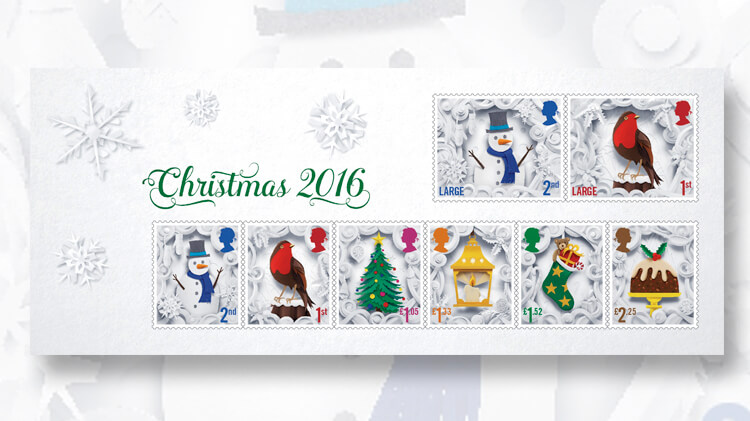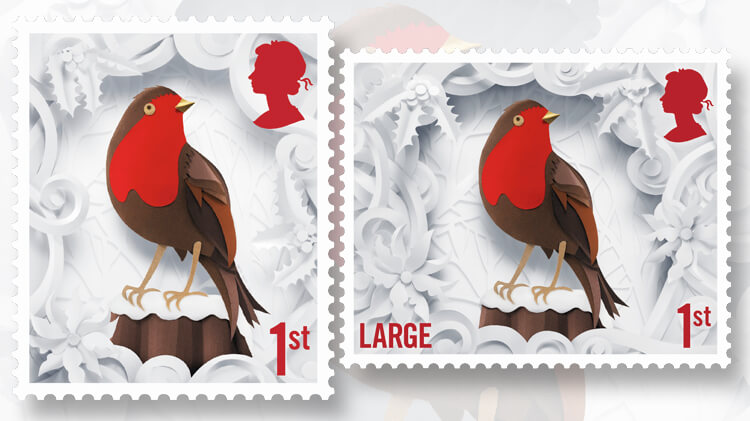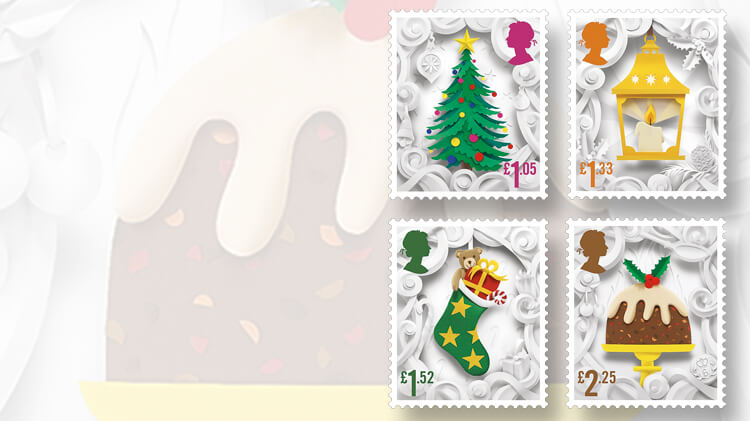World Stamps
Breaking down Royal Mail’s 2016 Christmas stamps
By Denise McCarty
Great Britain’s Christmas stamps for 2016 feature paper-cut sculptures highlighting British holiday traditions.
The paper-cut sculptures were crafted by Helen Musselwhite of Manchester, England.
According to a report in the Manchester Evening News, Musselwhite spent 18 months working on this project for Royal Mail.
Connect with Linn’s Stamp News:
Sign up for our newsletter
Like us on Facebook
Follow us on Twitter
In a press release from Royal Mail, Musselwhite said: “Illustrating the Royal Mail Christmas 2016 stamps has been one of the most important and favourite jobs of my career to date. I’m immensely proud that my work will be winging its way across the world sending Season’s Greetings far and wide from the UK.”
The issue includes eight stamps: a regular and large-size stamp each for first- and second-class mail, plus £1.05, £1.33, £1.52 and £2.25 denominations.
The two first-class stamps depict a robin. Royal Mail calls it a “robin redbreast,” adding that this bird “is synonymous with Royal Mail at Christmas. Its appearance on Christmas cards inspired by the red coats worn by postmen in Victorian times when postmen were known as ‘red breasts.’ ”
The current first-class rate is 64 pence for standard-size mail, and 96p for large letters.
Royal Mail defines standard-size mail as letters not exceeding 24 centimeters in length, 16.5 centimeters in width and 0.5 centimeters in thickness with a weight limit of 100 grams. Large letters can be up to 35.3 centimeters in length, 25 centimeters in width and 2.5 centimeters thick with a weight limit of 750 grams.
Pictured on the two second-class stamps is a snowman wearing a top hat and a blue woolen scarf. He has a carrot nose and sticks for his arms. Shown in the paper-cut frame around the snowman are a pair of mittens and snowflakes.
The current second-class rates are 55p for standard-size letters and 75p for large letters.
The £1.05 stamp, which pays the rate for mail to Europe up to 20 grams and to international countries up to 10 grams, shows a decorated Christmas tree with a star on top and additional ornaments and a bell in the paper-cut frame.
Illustrated on the £1.33 stamp is a lantern with a candle inside of it, and cut-out stars at the top. Also included in this design are berries, holly, and a pine cone. This denomination meets the rate for international mail up to 20 grams.
The stocking pictured on the £1.52 stamp is filled with a teddy bear, a wrapped package, and a candy cane. This stamp is for use on mail to Europe weighing up to 100 grams.
The £2.25 high denomination of the set matches the international rate for letters weighing up to 100 grams. The design features a Christmas pudding, also sometimes called a plum pudding and referred to as “figgy pudding” in the carol We Wish You a Merry Christmas. Pictured in the lower left of the design is a 6p coin, representing the surprise hidden in the pudding.
On a web page titled “Christmas traditions and coins,” the Royal Mint explains this tradition: “Stir-up-Sunday, the next before Advent, is the traditional day to make the Christmas pudding. Traditionally, a silver sixpence was stirred in to the mix, to bring the finder wealth and good luck in the year to come. In the past it was usual for every member of the household to give the pudding a stir and make a wish. Some families have used the same Christmas sixpence for as long as they can remember!”
The Chase, a design firm, designed the stamps. Jonathan Beer photographed Musselwhite’s paper sculptures for these designs.
De La Rue Security Print printed the self-adhesive stamps by gravure in sheets of 50 (sold in panes of 25 at most postal outlets).
The stamps for large mail measure 34 millimeters by 28mm each, and the other stamps are 24mm by 28mm, perforated 14.5 by 14.
A souvenir sheet includes all eight stamps with moisture-activated gum. The sheet is 179mm by 74mm.
The nondenominated first-class and second-class stamps for standard-size mail also were issued in separate booklets of 12, printed in gravure by International Security Printers (previously called Walsall); and in sheets of 16 (eight of each design) and sheets of 20 (10 of each design) with se-tenant labels.
The sheet of 16 shows a snowy rural landscape in the background, including a public mailbox.
The sheet of 20 celebrates 50 years of Great Britain’s Christmas stamps; its first two Christmas stamps were issued Dec. 1, 1966 (Scott 478-479). British Christmas stamps are shown in the selvage of this sheet, and the labels bear various greetings of the season.
The presentation pack also celebrates this anniversary. In addition to a mint set of stamps, this pack includes text by John Holman, stamp collector and former editor of the British Philatelic Bulletin.
Other products to be offered in conjunction with the Christmas stamps include first-day covers, and a set of nine postcards reproducing the designs of the eight stamps and the souvenir sheet.
Since 2005, Great Britain’s Royal Mail has issued Christmas stamps with religious designs on odd-numbered years, and stamps with secular designs on even-numbered years.
Royal Mail also is redistributing its 2013 Madonna and Child first- and second-class stamps for standard-size mail (Scott 3239-3230) to post offices this year. The stamps show paintings by Antoniazzo Romano and Francesco Granacci, respectively.
To order the Christmas stamps and related products, visit Royal Mail’s shop on the Internet. Ordering information also is available from Royal Mail, Tallents House, 21 S. Gyle Crescent, Edinburgh, EH12 9PB, Scotland.
Royal Mail’s two agencies in the United States are Interpost, Box 420, Hewlett, NY 11557; and the British Stamp Service in North America, 1 Unicover Center, Cheyenne, WY 82008.
MORE RELATED ARTICLES
Headlines
-
US Stamps
Oct 7, 2024, 3 PMMcMurtrie dismissed as APS education director following Sept. 21 arrest
-
US Stamps
Oct 7, 2024, 12 PMVasiliauskas named president of Mystic Stamp Co.
-
US Stamps
Oct 6, 2024, 5 PMApgar souvenir card available
-
US Stamps
Oct 6, 2024, 4 PMFirst Continental Congress and U.N. stamps receive Scott catalog numbers












